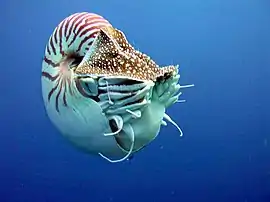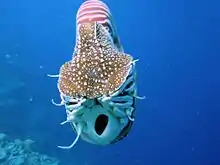Nautilus belauensis
The Palau nautilus, Nautilus belauensis, is mainly found in Palau in the Western Carolines[1] as its name suggests. It can be found on fore reef slopes[2] in depths ranging from 95m to 504m but typically prefers to remain within 150-300m where water temperatures range between 16.6 to 9.4ºC.[3] N. belauensis are highly mobile epibenthic scavenging herbalist and opportunistic predators that relies mostly on scent detection. [3] They are active both diurnally and nocturnally within the preferred depth range [3] although most shallow-water-incursions are usually nocturnal events that coincide with greatly diminished fish activities. [3]
| Nautilus belauensis | |
|---|---|
 | |
| Nautilus belauensis | |
| Scientific classification | |
| Kingdom: | Animalia |
| Phylum: | Mollusca |
| Class: | Cephalopoda |
| Subclass: | Nautiloidea |
| Order: | Nautilida |
| Family: | Nautilidae |
| Genus: | Nautilus |
| Species: | N. belauensis |
| Binomial name | |
| Nautilus belauensis Saunders, 1981 | |
Anatomy
N. belauensis’ shell is similar to that of N. pompilius, but it is distinguished by its larger mean mature shell diameter and shell weight. [4] Its shell characteristic pattern consists of bifurcating brown to red stripes that extend from the umbilicus to the venter without coalescing across the venter [4] with delicate, longitudinally crenulated ridges [1] that produce a distinctive, concentrically lirate pattern. [1] It can also be distinguished from N. pompilius by its inwardly sloping umbilical walls and evenly rounded umbilical shoulder. [5] The shell is also distinguishable by the presence of longitudinally crenulated shell sculpture, and a broadly triangular central rachidian radular tooth and a lack of umbilical callus. [4] Fresh shells were also found to implode at 680-789m depth equivalent pressures. [3]
Development
At the immature/juvenile stage the Palau nautilus’ shell is covered in colored bands. [2] Its body chamber is covered by a thick, gelatinous, and slippery periostracum. [2] As it reaches the sub mature stage, most of its body chamber is white but with thin margins. [2] However, it still lacks a black layer that develops upon maturity. [2]
Maturity in the Palau nautilus is reached when there is a rapid decrease in growth rate until there is no additional growth.[2] The body chamber shell wall thickens with deposition of a black layer along the apertural margin and the accentuation of the hyponomic and ocular sinuses. [2] The exterior body chamber lacks colour banding. [2] The last septum is thickened but has a reduced volume in the final chamber. [2] There are usually around 35 septa in the shell. [1] The maximum observed range in shell sizes extends from 180mm to 239mm in diameter [4] with the umbilical diameter taking up 16% of the shell diameter. [5] The Palau nautilus can live for 5-10 years after reaching maturity and have a life span that may range beyond 20 years. [2]
Behaviour
The Palau nautilus is able to traverse across a wide range of temperatures and great lateral distances in short periods of time. [6] It is also able to survive in warm water up to 30ºC for tens of hours up to several days. [3] It typically migrates from deeper water into shallower water following sunset and returns to the deep before sunlight. [6] It is also able to travel an average distance from 0.45km per day over 322 days up to 0.8km per day over 5 days. [6]
Gallery
 N. belauensis seen from the front, showing the hyponome
N. belauensis seen from the front, showing the hyponome Palau nautilus viewed from above
Palau nautilus viewed from above Diver with Palau nautilus showing size of a typical captured specimen
Diver with Palau nautilus showing size of a typical captured specimen
 Close-up view of the eye of the Palau nautilus
Close-up view of the eye of the Palau nautilus View of a Palau nautilus from the side
View of a Palau nautilus from the side A cage used to capture Palau nautiluses from a depth of approximately 30 m: note the five nautiluses and the mostly eaten chicken. The animals are released unharmed.
A cage used to capture Palau nautiluses from a depth of approximately 30 m: note the five nautiluses and the mostly eaten chicken. The animals are released unharmed.
References
- Saunders, W. Bruce (1981). "A New Species of Nautilus from Palau". The Veliger. 24 (1): 1-7.
- Saunders, W. Bruce (1983). "Natural Rates of Growth and Longevity of Nautilus belauensis". Paleobiology. 9 (3): 280–288. doi:10.1017/s0094837300007697.
- Saunders, W. Bruce (1984). "The Role and Status of Nautilus in its Natural Habitat: Evidence from Deep-Water Remote Camera Photosequences". Paleobiology. 10 (4): 469–486. doi:10.1017/s0094837300008472.
- Saunders, W. Bruce; Landman, Neil (2009). The Biology and Paleobiology of a Living Fossil. Springer Science & Business Media. pp. 41–43. ISBN 978-90-481-3299-7.
- Saunders, W. Bruce (1981). "The Species of Living Nautilus and Their Distribution". The Veliger. 24 (1): 41–43.
- Carlson, Bruce A.; McKibben, James N.; DeGruy, Michael V. (1984). "Telemetric Investigation of Vertical Migration of Nautilus belauensis in Palau". Pacific Science. 38 (3): 183–188.